I remember, a long time ago, as a kid, I would go with my grandpa to a farmer's market, where he would buy a couple of large, dark golden brown challahs. Back then, it was my favorite bread. It was pleasantly sweet, chewy, soft inside, and slightly crusty on the outside. I wished we would buy it every day, or even every week, but it only happened around holidays, a few times a year.
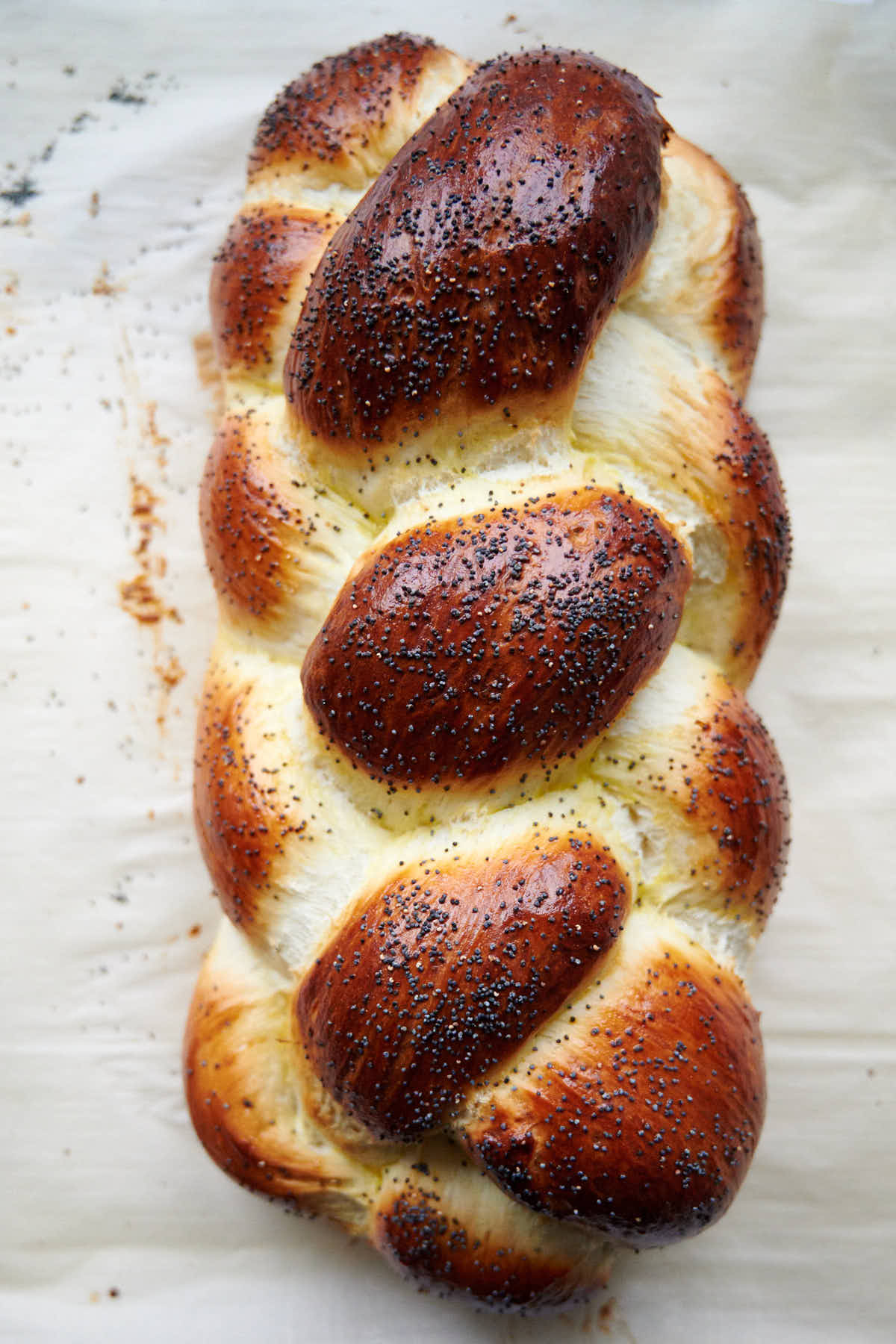
I've been looking for a challah bread recipe that would give me the same taste that I remember. Most challah recipes I've tried produce bread that is a bit, and sometimes much, too rich, too eggy, or too sweet for my taste. The one that I remember was like just slightly enriched plain white bread. It was tasty, almost too tasty; it was addictive. I liked having it with jam, butter or a few slices of sausage, or just eating it on its own.
After a lot of experimenting and reading up on old challah bread recipes, I seem to have finally come up with precisely what I was looking for. This challah tastes just like I remember it. My family loves it. I don't think it needs any more tweaking, but feel free to experiment with this recipe to customize it to your taste. From this recipe, you can make a single large, about a 3-lb bread, or two smaller loaves.
This challah is a looker; it's stunning. It will be a centerpiece at your holiday table, and people will be talking about it. I love the dark color of the crust. You get that from using an egg yolk wash. If you like a lighter color, use a whole egg wash.
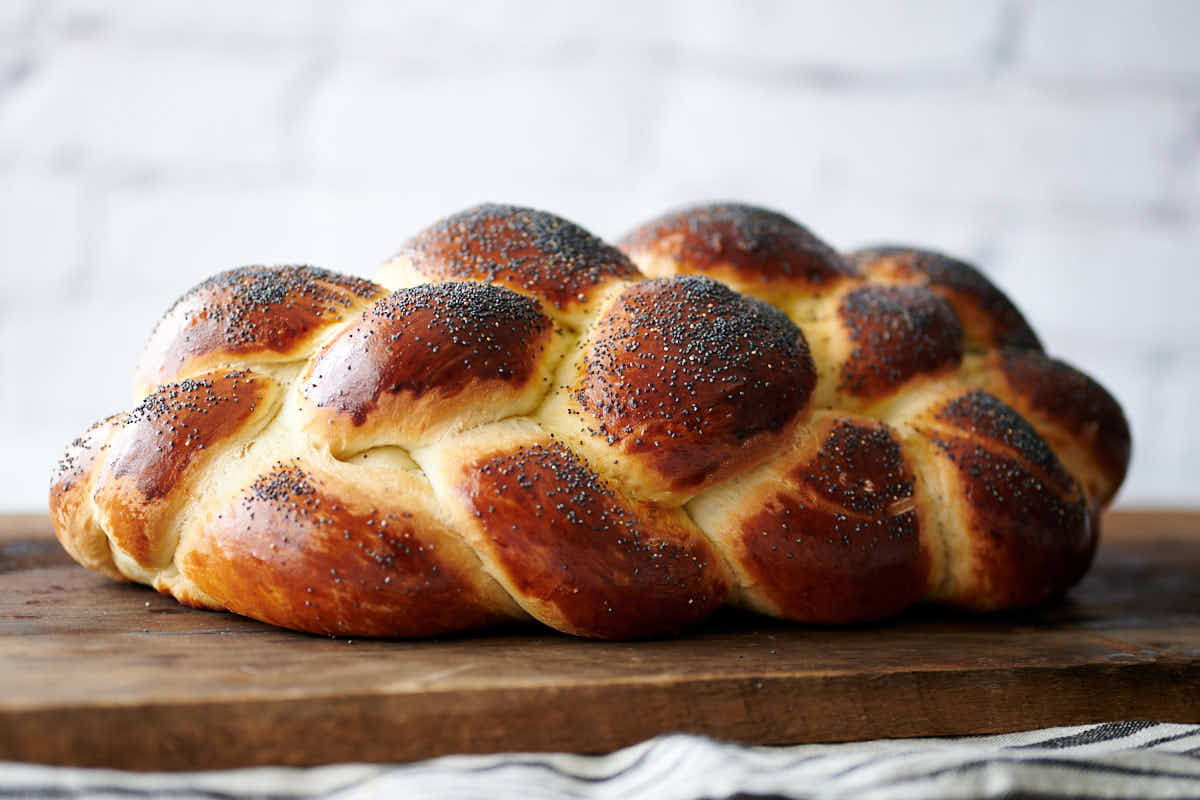
To make this challah bread I use a two-stage process. First, I make a poolish. The bread that utilizes poolish tends to have a richer taste and a chewier crumb. To make the poolish, I use 60% of the flour and almost all of the water, together with all of the yeast. Once the poolish is ready, doubled or even tripled in size, I mix the final dough. That's stage two. The rest of the process is fairly typical to any bread - bench resting the dough, shaping, proofing, and baking.
For a single large loaf, I use a 6-strand braid to shape my challah. Each strand is about 14 inches, with the middles quite thicker than the ends. This allows making a big, plump, gorgeous looking bread.
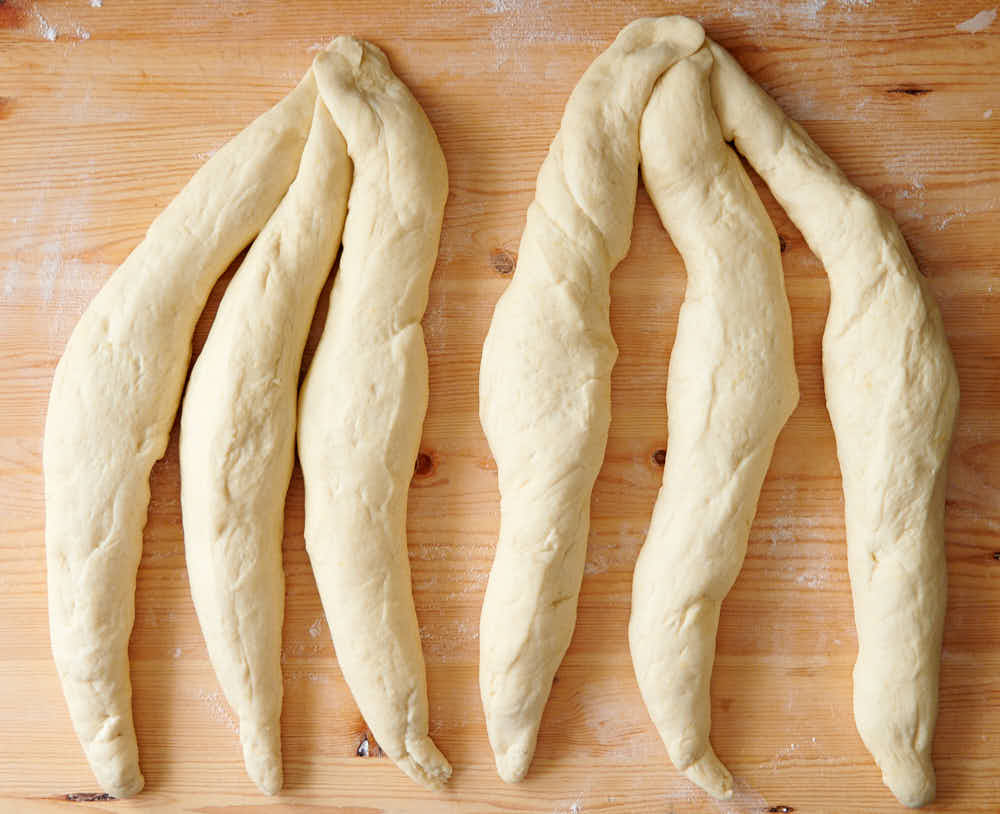
I keep the strands short, so I can get a stubby, plump loaf.
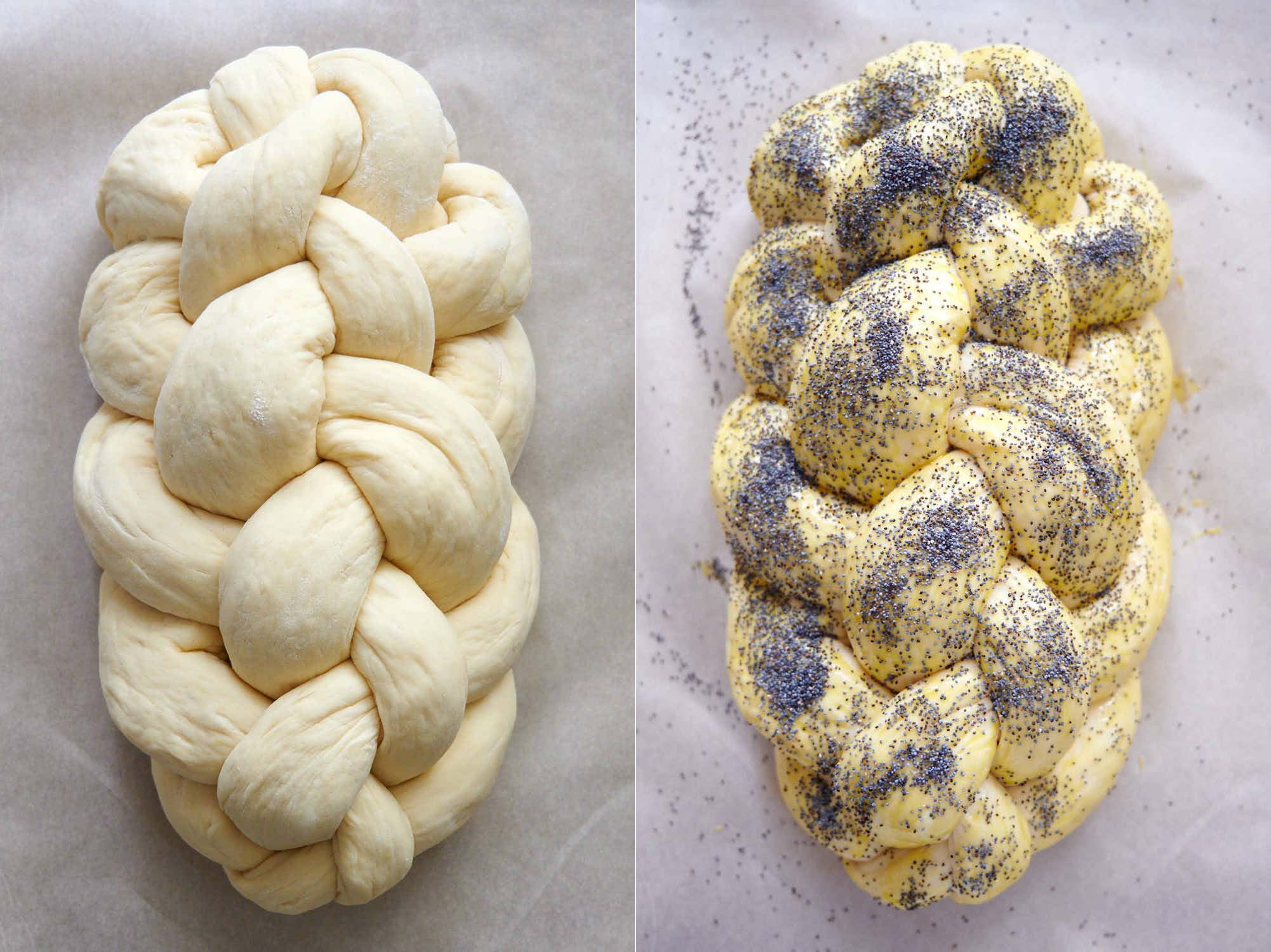
Here is the most helpful instruction video I was able to find on how to braid a six-strand challah. It has the right orientation so you can easily follow the instructions.
To make two smaller challahs, I use four-strand braiding. It's way easier than a 6-strand braid.
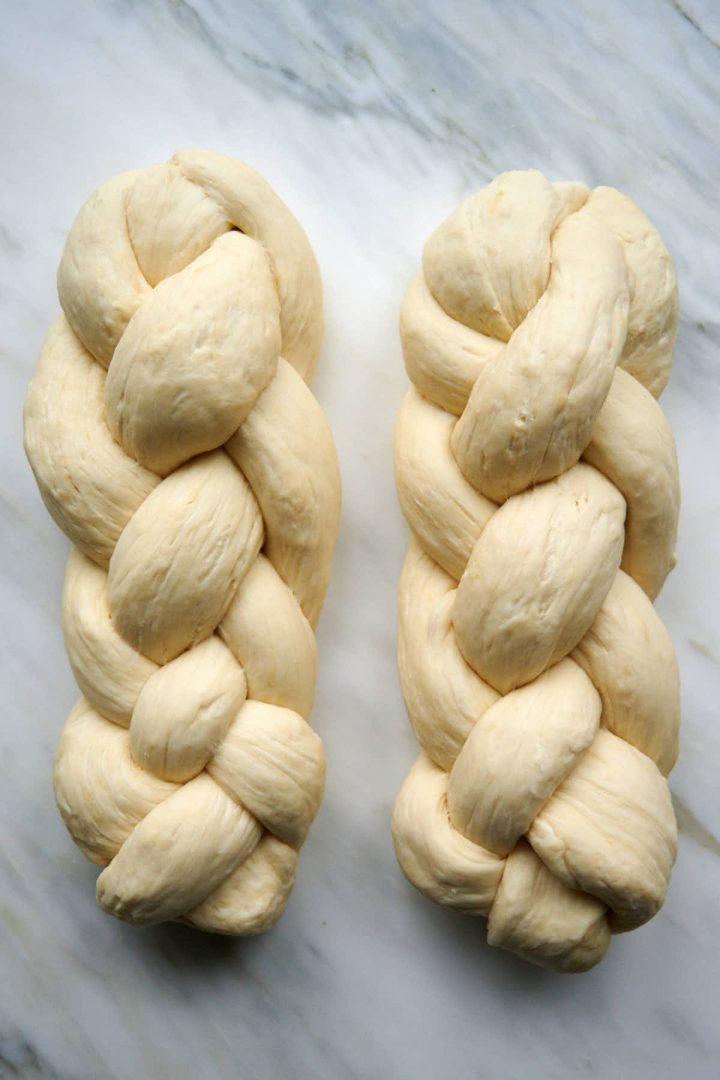
Here is a very helpful video on how to make a 4-strand braided challah:
Given the sugar and the egg in the dough, baking on a baking stone results in a slightly burnt bottom. This bread comes out better if baked on a baking sheet.
To get the color and the crust I was looking for, I bake my challah bread at 425F. This seems to work quite well in my oven, but you may have to adjust the temperature as, as they say, each oven bakes differently.
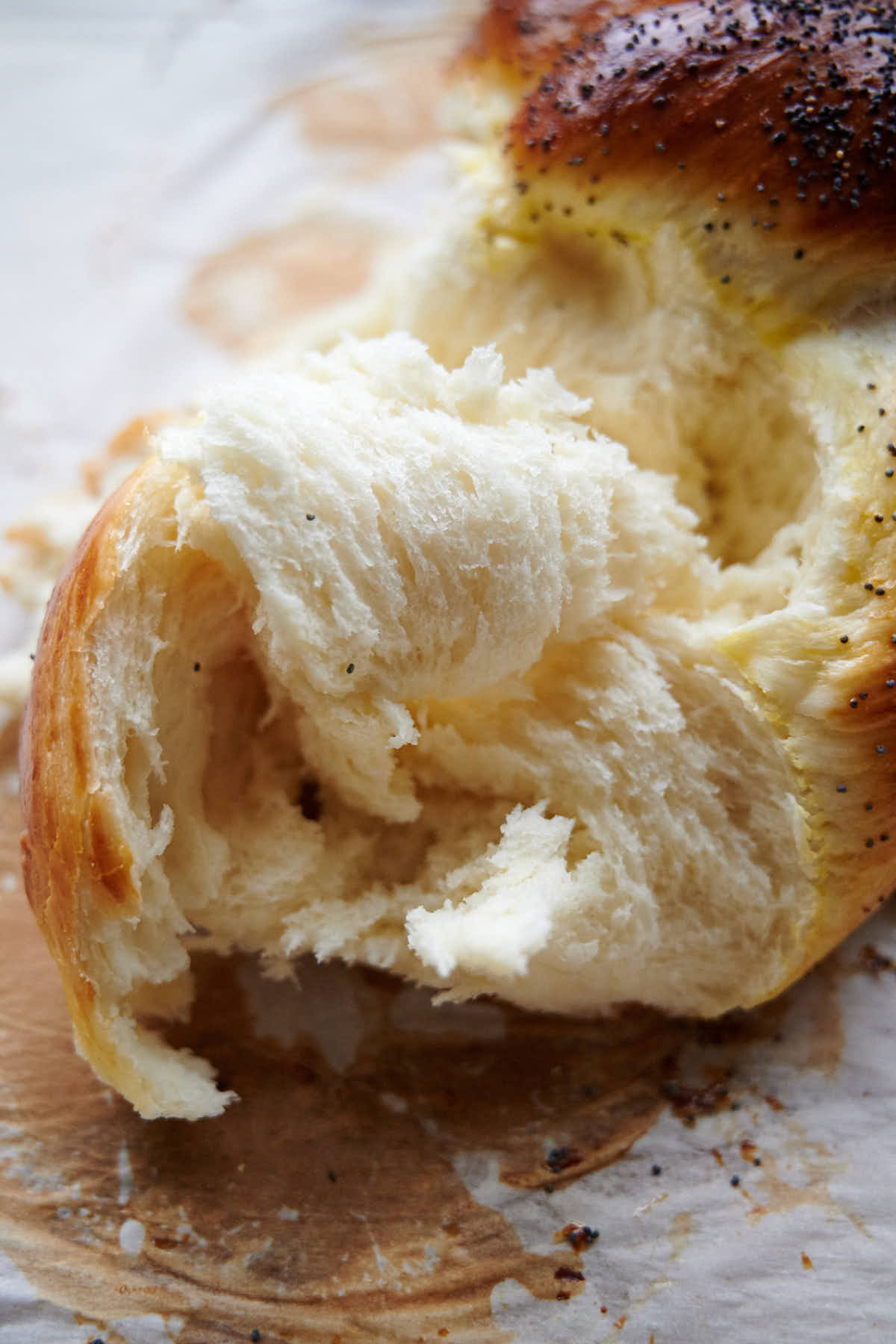
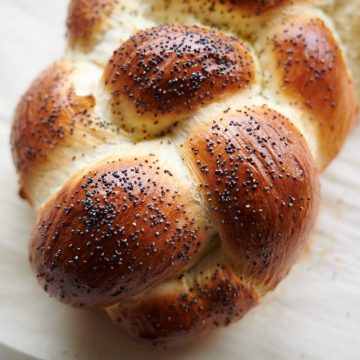
Challah Bread
Ingredients
Poolish
- 600 g all-purpose flour about 4 cups, using 'scoop and swipe' method
- 400 ml water about86F/30C; about 1 3/4 cups less 1 Tbsp
- 10 g instant yeast about 1 Tbsp; also known as Quick Rise or Rapid Rise yeast
Final dough (in addition to the poolish above)
- 400 g all-purpose flour about 2 3/4 cups, using 'scoop and swipe' method
- 80 ml water 86F/30C; about 5 1/2 Tbsp
- 15 g kosher salt about 1 Tbsp
- 70 g white sugar about 5 1/2 Tbsp
- 25 g butter melted; about 1 3/4 Tbsp
- 1 egg
Eggwash
- 1 egg yolk use the whole egg for a lighter color of the crust
- 1 tsp heavy cream
Garnish
- 3 Tbsp poppy seeds
Instructions
- To prepare the poolish, mix the flour with the water, and the instant yeast. Cover and let rise in a warm place for about 2 hours, until about tripled in size. I use a cold oven with the light on, it provides a perfectly warm environment.
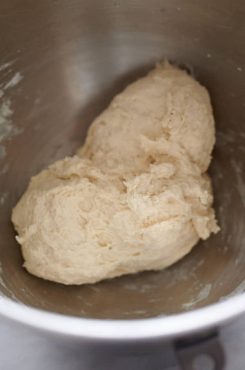
- Combine the poolish with the rest of the dough ingredients in a bowl of a stand mixer. Mix on low (Kitchen Aid setting 2) for 2 minutes. Cover and let rise in a warm place for about 45 minutes, or until doubled in size.
- If making one large loaf, divide the dough into 6 equal pieces. If making two smaller loaves, divide the dough into 8 equal pieces. Roll them out into 8"-10" logs. Cover and let rest for 20 minutes.
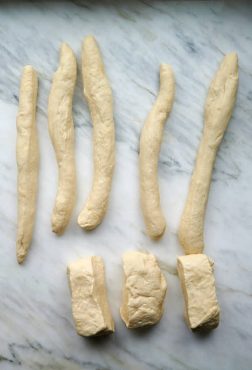
- On a lightly floured work surface (wooden is ideal), roll each log into a 14" long strand, making the ends thinner than the middles. Dust the strands with a little bit of flour to prevent sticking. Braid into a six-stranded challah bread if making a large challah, or two 4-stranded challahs if making two small loaves.
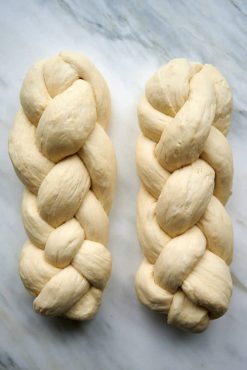
- Brush with the egg wash and sprinkle poppy seeds on top.
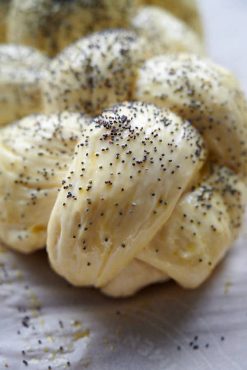
- Bake smaller loaves at 425F for about 20 minutes and large loaves for about 25-30 minutes. Chill for one hour before serving.


Ken says
Your challah is gorgeous , and I'm sure it's delicious. And while I am also a fan of using pre-fermented dough in challah, yours is closer to a sponge than a poolish.
Signed
-know-it-all
Victor @ Taste of Artisan says
Thank you. Perhaps... Chad Robertson of Tartine Bakery posted his Croissant Recipe in his Tartine Bread book some years ago. The recipe uses a similar pre-ferment, which he referred to as 'poolish'. I am not going to nitpick. 🙂
Kim H says
HI there- I'm confused why you don't have an additional proof after you braid your challah. (Usually in the realm of 45-60 minutes). I've always seen that added step when making challah, but yours goes right from the braiding stage into the oven. Is that because your recipes uses instant yeast (rather than another type)? Thanks.
Kim
Victor @ Taste of Artisan says
Hi, I think you may have answered your own question 🙂 The recipe works without the additional proofing. The 20 minute rest before braiding is enough. Any additional proofing will open up the crumb too much and make it too airy. That's not the texture I want in my challah. Happy baking!
Kim H says
Excellent. Thanks so much for clarifying!
Kim
Victor @ Taste of Artisan says
You are welcome. Enjoy!
Ronnie Cole says
Bread was delicious and easy to follow recipe.
Victor @ Taste of Artisan says
Enjoy!
Nancy says
Dough is going thru its second rise and really hoping it comes out ok. I am trying to make a “sweet” bread recipe similar to my aunt’s but she used whole milk. Do you think I could do seal for the water without making any other adjustments?
Victor @ Taste of Artisan says
Apologies for the delay responding. There appears to be a typo in your questions, but I think you are asking whether you could substitute water for milk. I think it will be fine without any additional adjustments. Good luck. Let me know how it turned out.
Kimberly Hanson says
Best Challah bread I have ever made. ♥️
Victor @ Taste of Artisan says
Enjoy! Every time I make it, it goes so fast.
Zahrah Ahmed says
How to substitute with active dry yeast and can a general black oven tray be used or will it burn the bottom?
Victor @ Taste of Artisan says
Simply activate in warm water with a pinch of sugar. Once you have a foam cap forming, it's ready to use.
Not sure I know what black oven tray you reference, is this the one with non-stick coating? Yes, it will work. I use aluminum baking sheets, those work well too. To avoid burning bottom, bake on a higher rack (if your heat comes from the bottom). Good luck!
Chantale says
The nutritional data does not guve portion size. Is that a one ounce slice? 2? Please advise.
Victor @ Taste of Artisan says
That would be 1/24th of the entire recipe. In other words, 1/24th of the loaf if making one large loaf or 1/12th of the loaf if making two smaller loaves.
Patti says
Finally I made my first challah loaf which means my first braid! I watched several videos that left me confused, but the video you posted on your site actually made it easy. Braiding for Dummies..I can see the book. But it worked and the bread is amazing! And so beautiful. The loaves are huge (4 braid) which is good because everyone wants some.
Again Victor, thanks.
Patti says
Oh also, I made it on parchment on the EH rectangular sheet pan. Worked perfectly.
Victor @ Taste of Artisan says
Thanks of this bit of information. Enjoy!
Victor @ Taste of Artisan says
You are very welcome, Patti. Glad it turned out great. This is one of my favorite breads, absolutely delightful... I loved it when I was a kid and still do. Cut a slice, spread some jam on it... yum! I had problems with braiding videos too until I found this one and the simple reason this video works so well is the perspective. You want the video to be from the point of view of the doer, not from the opposite side otherwise it gets super confusing as you have to mirror the movements.
Jane says
I have made it twice now, a huge hit with my family.
Victor @ Taste of Artisan says
Happy to hear that, Jane. Enjoy!
POLA says
Hi Victor,
This is a great and precise challah recipe. I made an excellent challah. Thanks a lot!!!
https://tasteofartisan.com/wp-content/uploads/2022/01/challah.jpg
Victor @ Taste of Artisan says
You are very welcome, Pola. Enjoy! If you have a picture to share, let me know.
Victor @ Taste of Artisan says
Beautiful challah, Pola. Thank you for sharing the picture.
Pola says
Hi Victor,
Thanks for your appreciation. I succeeded, because you published an exact recipe and exact explanations.
Best regards,
Pola
Victor @ Taste of Artisan says
You are very welcome, Pola. Happy baking!
Monica says
Hi Victor,
Thanks for this recipe. Am looking forward to make it. Just wondering if there will be a significant difference if I used bread flour instead of all-purpose flour? I noticed you use mostly all-purpose flour rather than high protein bread flour in your other breads too.
Regards,
Monica
Victor @ Taste of Artisan says
Monica, you've made an interesting observation. I use both, there are quite a few bread recipes on my blog that use bread flour. I often use them interchangeably. Both make good bread and the differences are subtle. There is an interesting article on this topic by King Arthur Baking - https://www.kingarthurbaking.com/blog/2016/07/21/substitute-bread-flour-all-purpose-flour.
There is a practical aspect to this as well. Bread flour is sold mostly in smaller packages at the store and is generally more expensive than AP per pound. You can buy it from bakery suppliers in large quantities (50lb bags) but that won't be practical for many home bakers.
To answer your question, yes, you can use bread flour in this recipe. I've used both bread and AP flour in this recipe but, again, the differences were quite subtle to be concerned about.
Also, different AP and bread flours will have different levels of protein content. I think there will probably be a noticeable difference between them if say the AP's protein is on the lower end and the bread's is on the higher end.
Ovoke says
This is an excellent recipe. It is the best bread I've made. Not too buttery or eggy.
I didn't make challah. I made 13 burger buns instead (120g each).
Here are changes I made to the poolish:
250g flour
250g water
0.2g yeast
I left the poolish overnight for 12hrs because it's warm here (Nigeria).
I look forward to trying other recipes.
Victor @ Taste of Artisan says
Cool idea to make burger buns with this dough... thanks for sharing. Happy baking!
Irena Bulatović says
How much fresh yeast should I use for this recipe?
Victor @ Taste of Artisan says
3 to 1 fresh to dry ratio works for me.
Harris says
Thanks for this recipe, that looks like one I really want - a chewy stringy challah.
I want to check before making the recipe - for the poolah, you state " ...mix the flour with the water, and the instant yeast." Does that mean no kneading, but simply mixing the ingredients for a minute or two in the blender. Or by spoon?
Victor @ Taste of Artisan says
Hi Harris, apologies for the delayed response. I mix in my mixer fitted with a dough hook. The idea is to mix the ingredients together until you get a homogeneous mass. You can just as easily do it by hand or a spoon.
Sivan says
It is really cold here, what temp would you recommend proofing the yeast? I have a sous vide and thought I could use it around 26.7 c . What do you think?
Victor @ Taste of Artisan says
Anywhere between 18 and 30 C will work. The higher the temp the faster it will ferment. The slower it will ferment the better the flavor will be developed. Never tried a sous vide bath for proofing but sounds interesting. When I want to expedite fermentation/proofing I put the dough in the cold oven and turn the light on - a perfect 28-30C.
Reva says
This is a really tasty bread like all your recipes they are all fab. Can’t wait to see any new future recipes
Reva says
Hi please can you tell me why the challah stretches in the oven I have let it prove as it said ?
Victor @ Taste of Artisan says
You mean oven spring where it rises up? Mine do sometimes too, not a bad thing I suppose but I see what you mean. You can try proofing a little longer so there will less of an oven spring.
Emma says
Hello, I can't wait to try this recipe this weekend.
I was just curious if instant dried yeast would yield the same result? As this is all I have to hand.
Thanks so much, really enjoying the site!
Victor @ Taste of Artisan says
Emma, I use instant dried yeast... I think we are talking about the same thing.
Emma says
Thanks Victor, used it today and loaf turned out great! Thanks for the fantastic recipe.
Victor @ Taste of Artisan says
You are very welcome, Emma. Please try my other recipes and subscribe as more are coming.
Richard says
Victor, I'm just writing to thank you for sharing this passion. I just recently learned about your site. As a long-time amateur and amateurish bread baker I am enjoying and learning from your experience.
Victor @ Taste of Artisan says
Hi Richard, welcome to my blog. Hope you are enjoying my recipe. Plenty more are coming soon. Happy baking!
Reva says
Thanks for your reply
Reva says
Hi can this be made the day before and put in the fridge overnight and baked the next day ?
Victor @ Taste of Artisan says
Definitely, but you would need to reduce yeast. I would follow a similar approach as in my French Baguette recipe.
Andrea says
Hi Victor, another great bread recipe. Though I have a favorite challah bread recipe, I like yours more. I learned a few new things from it. For example, your egg yolk and heavy cream egg wash gives the bread a much better color. Thank you and keep up the great work.
Victor @ Taste of Artisan says
You are welcome, Andrea. Happy baking and thanks for your feedback.